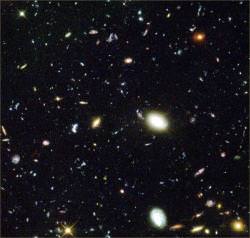We’re ready to complete our trilogy of discovery about the universe. We’ve learned that it has no center; rather everywhere is its center and nowhere. We discovered that the universe seems to be flat. It’s not open, it’s not closed, it’s flat. If that doesn’t make any sense, you need to listen to the previous show because there’s no way I could give that an explanation.
So now we want to know: “How big is it?†Does it go on forever or is it finite in scale? How much of it can we see?
Click here to download the episode
How Big is the Universe? – Show notes and transcript
Or subscribe to: astronomycast.com/podcast.xml with your podcatching software.


Dumb question which has nothing to do with the subject of the podcast.
Matter (say M) and antimatter (say A) differ only in their charges.
Einstein’s famous equation is (of course)
E== MC^2
If we use A instead of M, what difference is there (if any) between E=MC^2 and E=AC^2
If the same, why?
If not the same, again, why?
As I said, dumb question, but a question nevertheless.
Thank you
Bruno
Bruno,
M does not stand for matter. It stands for mass. Both matter and anti-matter has mass.
“It not open.”
What you say! You very rucky I know you meaning.
1/1=1
1/0=8[infinity]
0/0=1 & 8[infinity], is it or not? please verify?
Pi=3.1428…infinity[8]…Origin
Pi=3.1415926…[usa]…infinity[8]…Origin
How U make a circle O by 2 Legs?
such: Cosmic Religion By Albert Einstein is it? & KALAMASUTARA 10 Precepts is it?
So: Universe = 1 & 8[inffinity] is it?
if 0/0 = Percentage oh Yes, is it Balance State?
such: Earth: F=ma etc.
& Space-Time [Time in Space Vs Time on Earth]? Ralativity The-o-ry By Einstein
Nano Tech-nol-o-gy, next smaller than…
& next zero state…[may be dark matter or anti-matter]
nirvana [Mind State]…
action vs raaction force…
Logically the universe goes on forever. There couldn’t possibly be boundaries. How much of it can we see? Only a meaningless tiniest fraction can be seen by humankind. And how far is that? Only to the threshold where the expansion causes matter to disapears due to the speed of light.
Unfortunately, the limitations of the sensing facilities of humankind are never discussed in cosmology. We have five physical senses which are the foundation of our tools for observation in all matters and in all disciplines including astronomy. In instances where it is postulated that some effect exists that cannot be detected by our physical senses, we built instrumentation utilizing alternate physical effects which allow us to monitor the ancillary reactions. Lacking suitable monitoring instrumentation, unexplained astronomical events become, “DARK MATTER” or “BLACK HOLES”, etc. I submit what is actually infinite in the universe are those things of which humans are completely unaware.
I’m a layperson when it comes to physics, F.C., so I won’t pretend to understand all the formulas and equations that keep me from falling up… quantum physics in particular and cosmology in general didn’t interest me until my sophomore year in college, which was about 9 or 10 years ago, depending on how you look at it… anyway, I’ve been listening to your show since Juneish of ’07 and catching up on the popular lit (I’m becoming quite fond of yours and P.G.’s analogies – as well presented if not better than most of the mainstream physicists’). Thanks for your service to the science-loving community.
My question has to do with the fine-structure constant, and tepidly, the so-called anthropic principle. First, what is the relationship between the two–if anything–and secondly, why does the latter persist in its varying forms in cosmology still?
Hey Cab Tran! Good question. If you figure out why alpha equals 137, you might grasp the relationship between the fine-structure constant and the premise of the anthropic principle including its widely persistent variants in cosmology.
Do u open mind?
in Mind Thinking?
1+1=2
1+1=3
1+1=4,5,6,7,…
1+1=0
Family Tree Concept Thinking is it or not?, please verify? [or Life]. etc…